How Do You Know if Its a Quadratic Fit?
Regression Analysis > Quadratic Regression
Contents (Click to skip to that section):
- What is Quadratic Regression?
- The Quadratic Equation
- R-Squared
- Find the Equation with a Calculator
- Notice by Paw
What is Quadratic Regression?
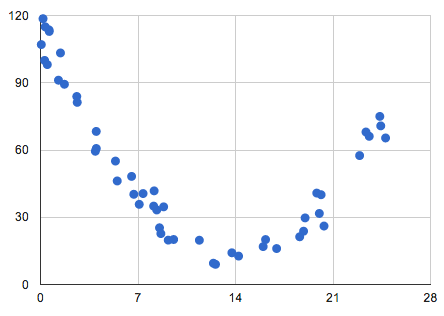
Information points that suggest quadratic regression would be a good fit.
Quadratic regression is finding the best fit equation for a set of data shaped like a parabola.
The first step in regression is to make a scatter plot. If your scatter plot is in a "U" shape, either concave upward (like the letter U) or concave down (∩), y'all're probably looking at some type of quadratic equation as the best fit for your information. A quadratic doesn't take to be a total "U" shape; y'all can take part of a it (say, a quarter or three/4).
Quadratic regression is an extension of simple linear regression. While linear regression can be performed with as few every bit ii points (i.due east. enough points to describe a straight line), quadratic regression come up with the disadvantage that it requires more data points to be sure your data falls into the "U" shape. It tin can technically exist performed with three data points that fit a "5" shape, merely more points are desirable. As more data points are required, it'southward likewise more costly than simple linear regression (Leeuwen, 2010).
Quadratic Regression Equation
Quadratic regression is a fashion to model a relationship between two sets of variables. The result is a regression equation that tin be used to make predictions near the data. The equation has the form:
y = ax2 + bx + c,
where a ≠ 0.
What is R-Squared in a Quadratic Regression?
R Squared (the coefficient of determination or R2), tells you how much variation in y is explained by x-variables. The range is 0 to 1, where 0 is 0% variation and 1 is 100% variation. It is used to analyze how differences in one variable tin be explained by a departure in a second variable. For example, when a woman gets significant has a direct relation to when they give birth, then R-squared would be close to 100%. On the other paw, R-squared would exist practically cipher for when a woman gets significant and when she throws a retirement party for a parent.
Find the Equation with a Reckoner
Contents:
- TI-83 Instructions
- TI-89 Instructions
TI-83 Instructions
Footstep 1: Printing STAT, then press ENTER to enter the lists screen. If y'all already have data in L1 or L2, articulate the data: move the cursor onto L1, press Articulate and so ENTER. Repeat for L2.
Step ii: Enter your x-variables, 1 at a time into the L1 cavalcade. Press the ENTER key after each entry.
Step 3: Use the arrow keys to scroll across to L2 (the next cavalcade to the correct).
Footstep 4: Enter your y-variables, i at a time. Press ENTER later each number.
Step v: Printing the STAT button, and then use the scroll fundamental to highlight "CALC."
Footstep 6: Arrow correct to calc and so arrow down to QuadReg. Printing ENTER.
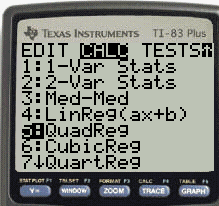
Step 7: Type in the following parameters: L1, L2, Y1. Hither'due south the steps to do that:
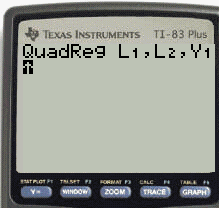
- Press [2nd] and so 1.
- Press the comma key.
- Press [2nd] and so 2.
- Press the comma cardinal.
- Press VARS, right arrow to Y-VARS and press ENTER.
- Choose Y1 and press ENTER.
Step 8: Press ENTER to summate the regression.
Tip: Printing GRAPH to graph the parabola. From there, you can determine if the equation is a good fit for the data.
TI-89 Instructions
Sample Trouble: Perform a quadratic regression TI 89 for the following data set:
x: ane, ii, 3, 4, 5, 6, 7, 8, 9
y: 32.v, 35.ix, 37.3, 37.9, 36.4, 32.7, 32.4, 29.5, 28.5
Pace one: Press APPS and then use the cursor keys to scroll to the Data/Matrix Editor. Printing ENTER.
Step 2: Select 1 for "Current."
Pace iii: Type your x-values into the c1 list and and so type your y-values into the c2 listing.
Stride iv: Press F5 for Calc. A new screen will appear.
Step 5: Blazon your x-values into column c1 and your y-values into cavalcade c2.
Step six: Move your cursor to the Calculation Type box, press the right-cursor key and select "ix:QuadRegReg."
Step 7: Type the location of your x-data into the "10" box. For example, if your x-values are in list c1 then type "c1."
Stride 8: Type the location of your y-data into the "y" box. For example, if your y-values are in list c2 then blazon "c2."
Step 9: Motion the cursor to the Store ReqEQ line and so press the right cursor key. Move the cursor to y1(x) and and so printing ENTER. A window volition pop up with the data for the quadratic regression equation y=ab10. The trigonometric regression equation will besides appear in the y1= line of the Y= screen.
This item quadratic regression equation is .34632 * x2 + 2.62653 * 10 + 31.51190.
Find by Mitt
In gild to find the quadratic regression by hand, y'all accept to solve the following system of equations:
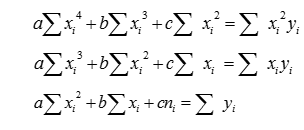
This fix of equations is sometimes called normal equations. If you are non familiar with the summation sign (Σ), the steps below should go far clear, but if y'all're still unsure you may want to read this summation annotation article for more than explanation.
Sample question:
Detect the quadratic equation for the post-obit set of data (this is every other information point from the sample calculator problem above, and so the solution should be very close to .34632 * xii + 2.62653 * x + 31.51190):
x: 1, 3, 5, 7, 9
y: 32.5, 37.3, 36.4, 32.iv, 28.five
Stride 1: Brand a table (I used Excel and then that the calculations would exist easier). Input your x-values in the starting time column and your y-values in the second column:

Step 2: Add together 5 more columns labeled x2, xiii, xiv xy, and ten2y:

Step 3: Calculate each cavalcade. For example, the x2 column is just the squares of the first column; the last column is the tertiary column multiplied by the second column (the y-values):

Step four: Sum the columns. As you might exist able to tell, this is where Excel really helps out with the calculations:
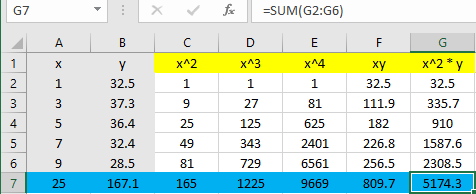
Step 5: Use the blueish row (the summations) to make full in the blanks. All you're doing is transferring the numbers to the normal equation (due north is the number of items in the set, which is five in our case):
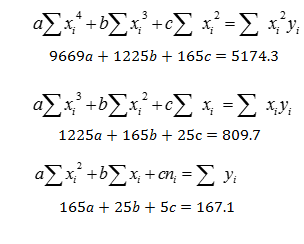
Stride 6: Solve the organisation of equations. I used this online calculator:
a = -0.3660714
b = 3.015714
c = thirty.42179
Stride seven: Insert the values from Footstep half dozen into the quadratic equation (I'one thousand rounding to three decimal places):
y = ax2 + bx + c
y = -0.366xii + iii.016x + 30.422
As we expected, that'southward very close to the TI-89 solution for all ix points
(.346x2 + 2.627 x + 31.511)
That's information technology!
References
Leeuwen, J. et al. (2010). SOFSEM 2010: Theory and Practice of Computer science: 36th Briefing on Electric current Trends in Theory and Practice of Computer science, Špindleruv Mlýn, Czechia, January 23-29, 2010. Proceedings
---------------------------------------------------------------------------
Need help with a homework or test question? With Chegg Report, you can get step-past-step solutions to your questions from an proficient in the field. Your start 30 minutes with a Chegg tutor is free!
Comments? Need to post a correction? Please post a comment on our Facebook page .
vanleuvenwaallovar.blogspot.com
Source: https://www.statisticshowto.com/quadratic-regression/#:~:text=If%20your%20scatter%20plot%20is,quarter%20or%203%2F4).
Post a Comment for "How Do You Know if Its a Quadratic Fit?"